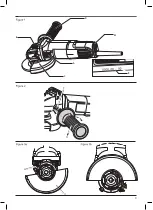
8
ENGLISH
FURTHER SAFETY INSTRUCTIONS
FOR ALL OPERATIONS
Causes and Operator Prevention
of Kickback
Kickback is a sudden reaction to a pinched or
snagged rotating wheel, backing pad, brush or any
other accessory. Pinching or snagging causes rapid
stalling of the rotating accessory which in turn causes
the uncontrolled power tool to be forced in the
direction opposite of the accessory’s rotation at the
For example, if an abrasive wheel is snagged or
pinched by the workpiece, the edge of the wheel
that is entering into the pinch point can dig into the
surface of the material causing the wheel to climb
out or kick out. The wheel may either jump toward or
away from the operator, depending on direction of the
wheel’s movement at the point of pinching. Abrasive
Kickback is the result of tool misuse and/or incorrect
operating procedures or conditions and can be
avoided by taking proper precautions as given below:
a)
Maintain a firm grip on the power tool and
position your body and arm to allow you to
resist kickback forces. Always use auxiliary
handle, if provided, for maximum control
over kickback or torque reaction during start
up.
The operator can control torque reaction or
b)
Never place your hand near the rotating
accessory.
Accessory may kickback over
c)
Do not position your body in the area where
power tool will move if kickback occurs.
Kickback will propel the tool in direction
opposite to the wheel’s movement at the point
d)
Use special care when working corners,
sharp edges etc. Avoid bouncing and
snagging the accessory.
Corners, sharp
edges or bouncing have a tendency to snag
the rotating accessory and cause loss of control
e)
Do not attach a saw chain woodcarving
blade or toothed saw blade.
Such blades
Safety Warnings Specific for
Grinding Operations
a)
Use only wheel types that are recommended
for your power tool and the specific guard
designed for the selected wheel.
Wheels for
which the power tool was not designed cannot
b)
The grinding surface of centre depressed
wheels must be mounted below the plane
of the guard lip.
An improperly mounted wheel
that projects through the plane of the guard lip
c)
The guard must be securely attached to the
power tool and positioned for maximum
safety, so the least amount of wheel is
exposed towards the operator.
The guard
helps to protect the operator from broken wheel
fragments, accidental contact with wheel and
d)
Wheels must be used only for recommended
applications. For example: do not grind with
the side of cut-off wheel.
Abrasive cut-off
wheels are intended for peripheral grinding, side
forces applied to these wheels may cause them
e)
Always use undamaged wheel flanges
that are of correct size and shape for your
selected wheel.
Proper wheel flanges support
the wheel thus reducing the possibility of wheel
breakage. Flanges for cut-off wheels may be
f)
Do not use worn down wheels from larger
power tools.
Wheel intended for larger power
tool is not suitable for the higher speed of a
WARNING:
We recommend the use of
a residual current device with a residual
Residual Risks
In spite of the application of the relevant safety
regulations and the implementation of safety
devices, certain residual risks cannot be avoided.
These are:
– Risk of burns due to accessories becoming hot
Markings on Tool
The following pictograms are shown on the tool:
Summary of Contents for DWE4119
Page 1: ...DWE4119 ...
Page 2: ...English 5 original instructions ...
Page 3: ...3 A D E D F C E B D A C M L 2 ...
Page 4: ...4 H G K J I K I H G ...
Page 15: ......
Page 16: ...N855938 05 2020 ...


































